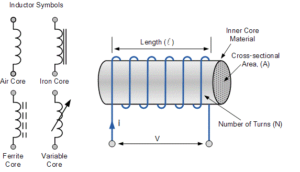Table of Contents
Faraday’s law of induction states that as the current flowing through the coil changes, the time-varying magnetic field generates an electromotive force (e.m.f.) (voltage) in the conductor. According to Lenz’s law, the induced voltage has a polarity (direction) that is opposite to the current shift that created it. Inductors, as a result, resist all current fluctuations that flow through them.
The ratio of the voltage to the rate of change of current is known as the inductance of an inductor. The henry (H), named after 19th-century American physicist Joseph Henry, is the unit of inductance in the International System of Units (SI). It’s the same as weber/ampere when it comes to measuring magnetic circuits. Inductors commonly have values ranging from 1 H (1006 H) to 20 H. Inside the coil of many inductors is a magnetic core composed of iron or ferrite, which increases the magnetic field and therefore the inductance.
Lenz’s law
The induced voltage’s polarity (direction) is determined by Lenz’s law, which specifies that the induced voltage will oppose the change in current. If the current through an inductor increases, for example, the induced voltage will be positive at the current’s entry point and negative at the current’s exit point, tending to resist the increased current. The energy from the external circuit that is required to overcome this potential “hill” is stored in the inductor’s magnetic field. If the current decreases, the induced voltage will be negative at the current’s entry point and positive at the current’s exit point, which will tend to keep the current constant. The magnetic field’s energy is returned to the circuit in this situation.
Lenz’s law is a law that states that the current in a circuit is in the direction that opposes the change in flux that created it. In other words, the current will flow in a direction that will try to keep the flux constant.
Lenz’s law is important in electrical engineering because it helps to predict the direction of current in a circuit. This is important for designing circuits, as well as diagnosing problems with circuits.
Description
The magnetic permeability of adjacent materials as well as the shape of the current channel determine the inductance of a circuit. An inductor is a component with two terminals that consists of a wire or other conductor structured to enhance the magnetic flux across the circuit, commonly in the shape of a coil or helix. The number of times the magnetic flux lines join the circuit grows when the wire is wound into a coil, increasing the field and consequently the inductance. As the number of turns grows, so does the inductance. The inductance is further affected by the coil’s form, turn separation, and a variety of other variables.
FAQ’S
What is the purpose of an inductor?
Inductors are typically used for the following reasons in electrical power and electronic devices: High-frequency noise in electrical circuits involves choking, obstructing, attenuating, or filtering/smoothing. Energy is stored and transmitted in power converters (dc-dc or ac-dc).
In basic terms, what is an inductor?
A passive electrical component called an inductor stores energy in the form of a magnetic field. An inductor is a wire loop or coil in its most basic form. The coil's inductance is proportional to the number of turns it has.
Q. What is the inductor symbol?
Ans. Units and Symbols for Inductors
Henry (H) is the SI Unit of Inductance, named for American scientist Joseph Henry.








